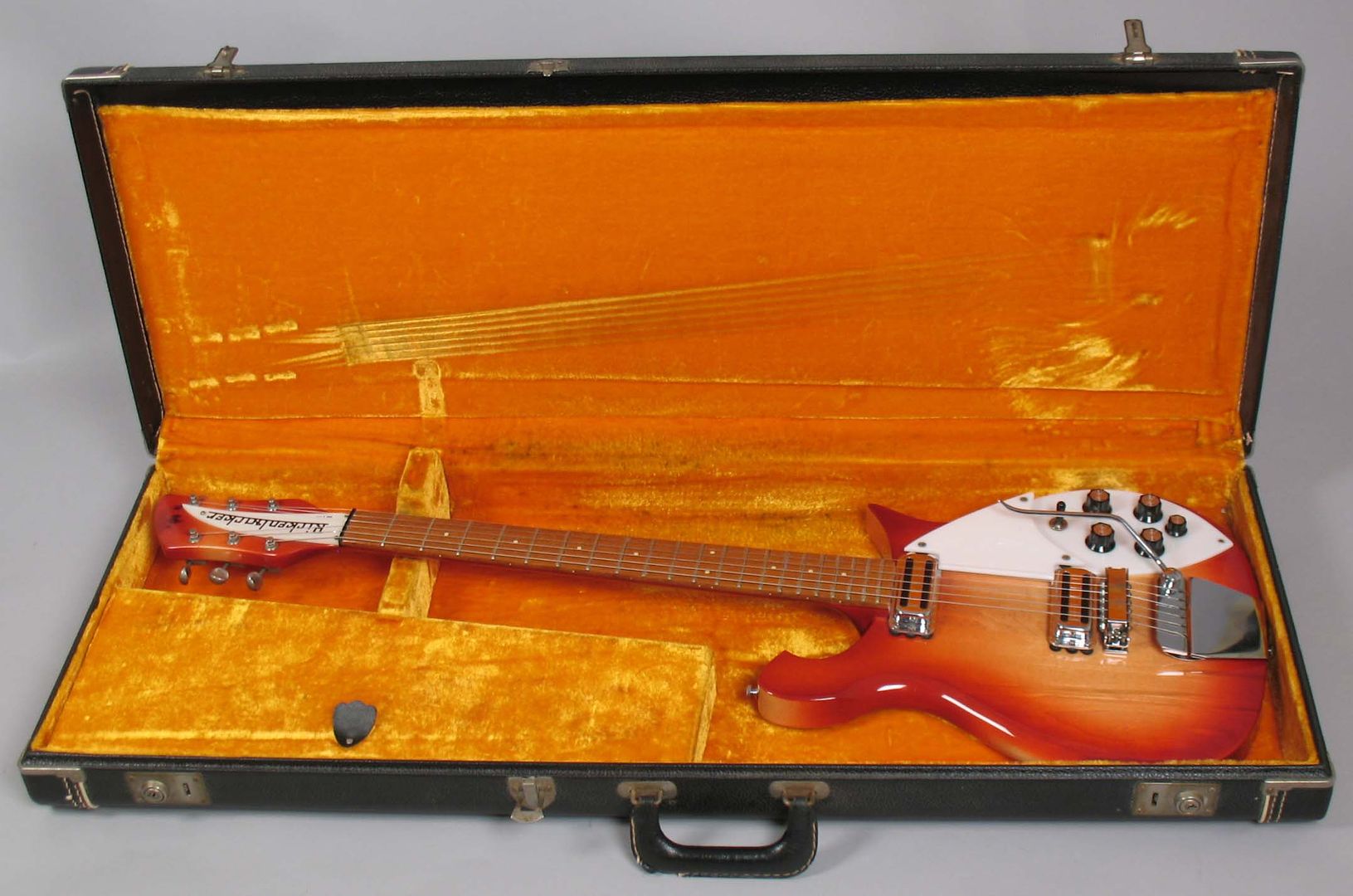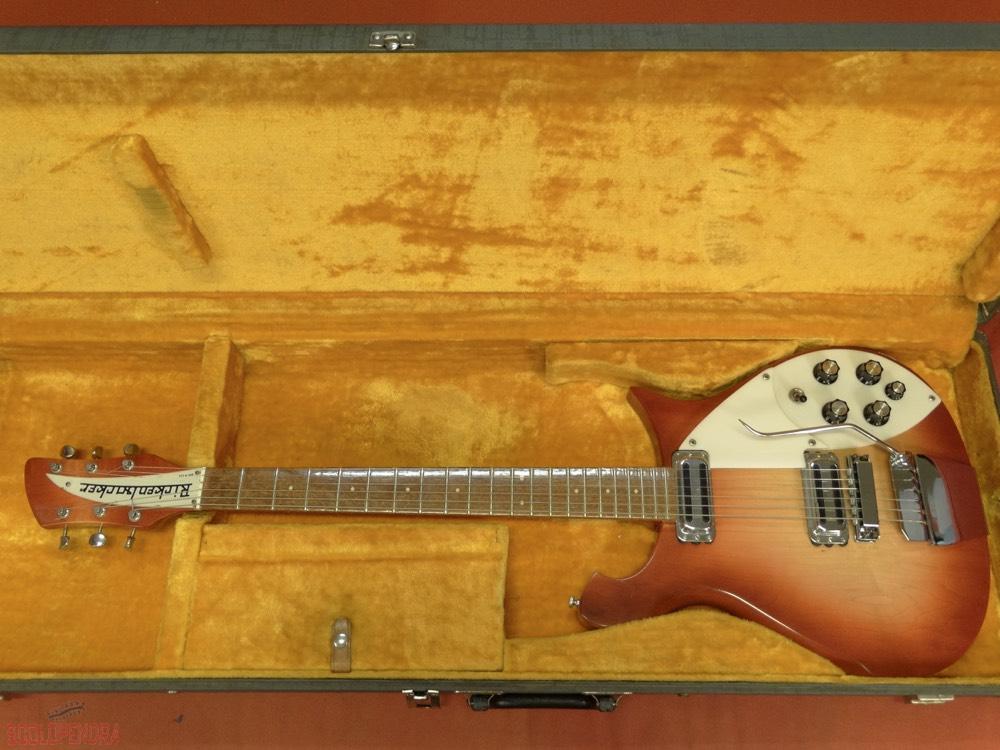May 1967 and the ‘mystery cases’
Posted: Mon Aug 28, 2023 7:14 am
As proud new owner of a May 1967 615 (GE2365, see my other today's posting) I have looked in awe at the wealth of information contained in the Register, a terrific resource. I noted some kind of anomaly that seems to occur in particular with regard to guitar cases in that May 1967 month.
When looking at the registered full scale solid body Ricks with the ‘cresting wave’ shape made in during the 1960s, and at other internet sources, it seems fair to say that the great majority of these 1960s guitars (models 420, 425, 450, 456, 460, 615 and 625) still have/had their silver factory cases at the time they were listed or offered. This applies generally to all of these guitars, even the cheaper models. But in May ’67 only, the situation seems quite the opposite: of the fourteen registered guitars whose entries have case photos, only three (!) have their original case, among which one 615 (or one out of six registered), one 625 (one of three) and one 450 (one of five). Some of these guitars, like mine, are in original, excellent or even near mint condition, but do not have the silver case.
So what happened here? Most of the ‘non-silver’ cases on these guitars look to be US made, with many being of the Fender type with black tolex and leather ends, dating seemingly to the 1960s or so. What is different though are the insides: various lining colors (blue, yellow/orange, red) and pockets (some do not have these, others do). My speculation therefore is that the company ran out of the silver cases during May, and used any other case from US makers they could get their hands on to ship out guitars until a new batch of silver cases arrived, with the most ‘replacement’ cases possibly coming from the Victoria Luggage Co, which also made cases for Fender during this period (John Hall has confirmed on this forum that both Fender and Rickenbacker ordered cases from this company at the time). Here is a shot of minty GE2461, with a black/orange case:

The case on my guitar is also interesting: it conforms to the Fender type design on the outside, but has dark grey tolex covering, and on the inside there are two side cushions that provide a better fit for the instrument. The central latch has a marking of the T&S company of Worcester, Mass, and the case seems to be as old as the guitar. The outer locking latches look rather peculiar. I found out that many of the 1960s Ampeg-Burns guitars were shipped in a very similar type of case with these typical latches that I have not seen anywhere else (these Ampeg-Burns cases were US made, and were very different from the cases that Burns supplied with their guitars in Europe). Here is mine:

You guessed it, I am trying to argue that the case that came with my very nice 615 is, in fact, the original case in which it was shipped. I fully admit this is mere speculation, but the May ’67 pattern is so completely different from any month before, of after, that this theory is really tempting and could be true, though any debunkers are very welcome to chime in.
To close with John Hall (2003): “Through the years a variety of interior colors of the "whore house plush", as it is called, has been used. It was simply a matter of availability to the case makers, as well as the fact that in the past we've had multiple case makers simultaneously. It's impossible to pin a certain color (or even exact style of case, for that matter) to a particular time period.”
I rest my case (pun intended!).
When looking at the registered full scale solid body Ricks with the ‘cresting wave’ shape made in during the 1960s, and at other internet sources, it seems fair to say that the great majority of these 1960s guitars (models 420, 425, 450, 456, 460, 615 and 625) still have/had their silver factory cases at the time they were listed or offered. This applies generally to all of these guitars, even the cheaper models. But in May ’67 only, the situation seems quite the opposite: of the fourteen registered guitars whose entries have case photos, only three (!) have their original case, among which one 615 (or one out of six registered), one 625 (one of three) and one 450 (one of five). Some of these guitars, like mine, are in original, excellent or even near mint condition, but do not have the silver case.
So what happened here? Most of the ‘non-silver’ cases on these guitars look to be US made, with many being of the Fender type with black tolex and leather ends, dating seemingly to the 1960s or so. What is different though are the insides: various lining colors (blue, yellow/orange, red) and pockets (some do not have these, others do). My speculation therefore is that the company ran out of the silver cases during May, and used any other case from US makers they could get their hands on to ship out guitars until a new batch of silver cases arrived, with the most ‘replacement’ cases possibly coming from the Victoria Luggage Co, which also made cases for Fender during this period (John Hall has confirmed on this forum that both Fender and Rickenbacker ordered cases from this company at the time). Here is a shot of minty GE2461, with a black/orange case:

The case on my guitar is also interesting: it conforms to the Fender type design on the outside, but has dark grey tolex covering, and on the inside there are two side cushions that provide a better fit for the instrument. The central latch has a marking of the T&S company of Worcester, Mass, and the case seems to be as old as the guitar. The outer locking latches look rather peculiar. I found out that many of the 1960s Ampeg-Burns guitars were shipped in a very similar type of case with these typical latches that I have not seen anywhere else (these Ampeg-Burns cases were US made, and were very different from the cases that Burns supplied with their guitars in Europe). Here is mine:

You guessed it, I am trying to argue that the case that came with my very nice 615 is, in fact, the original case in which it was shipped. I fully admit this is mere speculation, but the May ’67 pattern is so completely different from any month before, of after, that this theory is really tempting and could be true, though any debunkers are very welcome to chime in.
To close with John Hall (2003): “Through the years a variety of interior colors of the "whore house plush", as it is called, has been used. It was simply a matter of availability to the case makers, as well as the fact that in the past we've had multiple case makers simultaneously. It's impossible to pin a certain color (or even exact style of case, for that matter) to a particular time period.”
I rest my case (pun intended!).